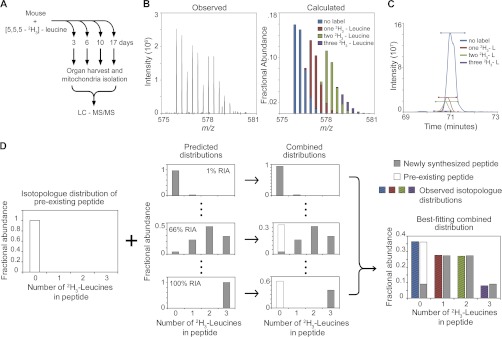Fig. 1.
Overview of experimental design and analysis by Topograph. A, Mice were fed a diet containing [5,5,5-2H3]-leucine. At 3, 6, 10, and 17 days, the mice were euthanized, liver, and heart tissues were harvested and mitochondria were isolated. The isolated mitochondria were digested with trypsin and then analyzed by LC-MS/MS. B, An example of an observed peptide isotope distribution and its predicted isotopolog deconvolution by Topograph. The deconvolution was done for every MS scan of an identified peptide isotope distribution. C, A plot of the summed ion signal for each isotopolog over time. The horizontal bars above each peak indicate the time range used to calculate the integrated ion signal for each isotopolog. Peptides containing deuterated leucines are more hydrophilic and elute in the lower organic mobile phase portion of the gradient (24). D, Overview of process used to determine the amino acid precursor pool relative isotope abundance (RIA) initial estimation and the ratio of pre-existing/newly synthesized peptide. The isotopolog distribution of pre-existing peptides is combined with the predicted distributions of newly synthesized peptides at each RIA from 1% to 100%. A least squares comparison determines the optimum pre-existing:newly synthesized peptide ratio. A second least squares comparison determines the combined distribution that best fits the observed isotopolog distribution.

